Among the downsides of being someone within a perfectly average height range for humans is that nearly everyone else’s face and mouth is always so close to mine, particularly when we’re pointing our faces and mouths at each other. This is arguably a good thing in “normal” times when I’m forced to make eye contact and talk to other people, but during coronavirus, it’s a nightmare.
Is there, though, an ideal height that would permanently keep someone with a tall enough frame socially distanced from the mouth-breathers below them?
Not exactly — even for the tallest humans among us.
“The idea behind the 6-feet socially-distanced bubble is to keep that much distance between individuals so droplets that become airborne have a lower chance to be transmitted because they can’t travel that far,” explains Alti Iftikhar, a physician in Florida. “In theory, maybe the 7-foot-6 Yao Ming would be ‘socially distanced’ from a 1-foot tall baby. But even then, he’d have to be standing up the entire time — and the guy already has bad knees.”
However, Yao would only be safe if the baby didn’t sneeze or cough, and in the meantime, the baby would be getting bathed in droplets of Yao’s saliva every time he opened his mouth. Such is the reason David Westenberg, associate professor of biological sciences at Missouri University of Science and Technology, argues that for whatever minimal advantage taller people might have distance-wise from shorter people, they actually pose a greater risk to others.
To start, Westenberg — who goes by @GermJuggler on Twitter — points to the physics of a sneeze as captured by high-speed cameras:
Next, he cites a Twitter thread in which “someone measured how far ‘germs’ travel in the air by looking at bacteria that land on a petri dish after coughing with or without a mask” (despite obviously not being a rigorous scientific experiment and the fact that it’s working with bacteria and not a virus, Westenberg says the thread is a good, simple demonstration of the concepts at play):
What about keeping your distance?
Second demo: I set open bacteria culture plates 2, 4 and 6 feet away and coughed (hard) for ~15s. I repeated this without a mask.
As seen by number of bacteria colonies, droplets mostly landed <6 ft, but a mask blocked nearly all of them. pic.twitter.com/8wDdvIHHMa
— Rich Davis, PhD, D(ABMM), MLS ??? (@richdavisphd) June 26, 2020
Overall, the experiment shows that 6 feet of distance provides a good, but not absolute, level of protection in terms of the distance between people. As for how much height factors into that distance, he explains, “One thing you’ll notice from the sneezing demonstration is that most of the droplets tend to drop fairly quickly with the larger droplets falling the fastest. You’ll also notice in the petri dish experiment, the person who was coughing was standing above a table that basically came up to his waist. So these show that the droplets tend to drop over distance.”
This suggests that while tall people “may be somewhat ‘safer’ from inhaling someone else’s droplets,” as in the Yao Ming-baby hypothetical, their droplets are falling on everyone below them.

There is a debate about whether coronavirus is technically an aerosol, but there is no doubt that it spreads via droplets of spit floating around in the air. According to the Proceedings of the National Academy of Sciences, large droplets containing coronavirus mainly settle on the ground and cause surface contamination, but smaller droplets can remain in the air for a long time, as well as travel long distances (relatively speaking) — particularly if someone is coughing, sneezing or talking. (To that end, Lydia Bourouiba, a particle fluid dynamicist at MIT, has recommended that people remain 27 feet apart from each other.)
In terms of the topic at hand — height — because microbes “can travel pretty far in the air, requiring them to travel up as well as out,” Westenberg continues (emphasis mine), “being taller may not provide much protection.” (Current CDC coronavirus-tracking data doesn’t break down coronavirus cases by height so there are no official numbers in this regard.)
It still, however, holds true that larger “droplets tend to spread out and then fall fairly quickly, so a taller person may be more likely to spread germs to others and should be more careful about protecting others.”
In other words, there’s never been a better time for all you tall people out there to look out for us little people.

